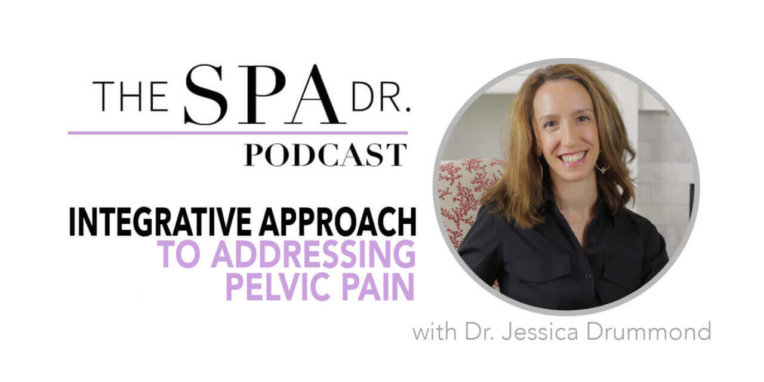On today’s podcast we’re covering pelvic pain. This is important to listen to if you are a woman experiencing pain in the pelvic area, such as from painful periods, endometriosis, a history of sexual trauma, physical trauma from childbirth, constipation, or pain during intercourse.
My guest is Dr. Jessica Drummond, DCN, CCN, PT. She is the founder and CEO of the Integrative Women’s Health Institute and is passionate about caring for and empowering women who struggle with women’s and pelvic health conditions. Having two decades of experience in women’s and pelvic health as a physical therapist and functional nutritionist, plus owning a private women’s health clinical nutrition and coaching practice, gives her a unique perspective on the integrative options for pelvic pain management, preconception and fertility support, postpartum recovery, and chronic pain management.
In this interview we discuss the types of pelvic pain, root causes behind them and how to address them. So please enjoy this interview…
To learn more about Dr. Jessica Drummond, go to https://integrativewomenshealthinstitute.com/
Grab your 4 Challenges to Relieving Pelvic Pain And, How to Solve Them (Even if You’ve Tried Everything) : HERE
TRANSCRIPTION:
Trevor: Hi there. I’m Doctor Trevor Cates. Welcome to the Spa Doctor podcast. On today’s podcast, we’re talking about pelvic pain. This is important to listen to if you’re woman experiencing pain in the pelvic area, such as from painful periods, endometrioses, a history of sexual trauma, physical trauma from childbirth, constipation, or pain during intercourse. My guest is Doctor Jessica Drummond. She is founder and CEP of Integrated Women’s Health Institute, and is passionate about caring for and empowering women who struggle with women’s and pelvic health conditions. Having two decades of experience in women’s and public health as a physical therapist and functional nutritionist, plus owning a private women’s health clinic, nutrition and coaching practice gives her a unique perspective on the integrative options for pelvic pain management, preconception and fertility support, post partum recovery and chronic pain management. In this interview, we discussed the types of pelvic pain, root causes behind them and how to address them. So please enjoy this interview.
Trevor: Jessica, it’s great to have you on my podcast.
Jessica: Thanks so much for having me. It’s a pleasure to be here.
Trevor: So we’re talking about pelvic pain today, I wanna first start with your story, your journey. What led you to specializing in this?
Jessica: Well, I began my career as a physical therapist almost 20 years ago now, and I started in sports medicine because I was an athlete as a child and young adult. But I had several patients who I was working with for various reasons, orthopedic related, so shoulder pain for example related to a breast cancer surgery, or spine and back pain related to pregnancy and post partum. And pretty quickly, within about the first three years of my practice, I began to specialize in women’s health, and a lot of that was those orthopedic issues; incontinence therapy, therapy for pelvic pain. And I found that pelvic pain was one of the most challenging patient populations to work with because, as you know, chronic pain in any situation has a lot of underlying root causes. It can be highly variable, and once the pain is somewhat centralized in the nervous system, it can be very much of a challenge to overcome.
Jessica: But over the years, as I progressed from physical therapy into having my own hormonal crash after the birth of my first daughter, and then I began to get more educated and ended up getting a doctorate in clinical nutrition from a functional medicine standpoint. And I realized that all of these tools that I had from functional medicine, functional nutrition could be very valuable for my patients with pelvic pain who would plateau with just either western medicine or western medicine in combination with physical therapy. There was a lot we could offer these patients with nutrition and lifestyle medicine, and especially when the cases were really challenging. So it was a professional journey that kind of overlapped with my own healing.
Trevor: Well, and a lot of times that is the case with us, is we have our personal and then we end up specializing in that or having that be a big passion of ours, and then we wanna help other people. So yeah, it makes a lot of sense. So talk about pelvic pain. Where does it come from, and what exactly is it? I mean, I think we know where the pelvis is, but what all is associated with that?
Jessica: Yeah. So we think it’s kind of normal to have period pain. Right? There’s all the commercials like, “Oh, you’re gonna be down for a couple of days at the beginning of your period.” But that’s actually not normal. It is normal to have a little bit of fatigue, mild cramping surrounding your period, that’s not disruptive, not bothersome. You shouldn’t have to take any medication for it. But if you had period pain that’s very painful, to the point where you’re missing school or you’re missing work or you have to take medication, that’s actually not normal. It’s extremely common, but it’s not normal. And there’s actually a nonprofit organization called The Fifth Vital Sign. It’s an indicator that when you have period pain or period irregularities, or things like that, it’s actually an indicator that there are other things going on with your general health. Your hormonal balance is off. You may have chronic inflammation. And so there are many root causes for pelvic, and the pain doesn’t have to be cyclical.
Jessica: So in many women, it is cyclical, related to their menstrual cycles. It might be ovulation pain. It might be period pain. It might be both. But it can also be a-cyclical, it can just happen. You can have bad kind of pelvic and abdominal pain, pain in that region. And some of the most common causes are things like endometriosis, painful bladder syndrome, so you can have urgency and frequency and bladder symptoms along with pelvic pain. Painful bladder syndrome is also called interstitial cystitis. Vulvodynia, so if the pain is more painful sex or pain using tampon or pain with gynecologic exams, you might have vulvodynia. So it depends.
Jessica: Within the pelvis … I think of the pelvis as this big bowl for many of our organ systems. You might have IBS and constipation. You might have bladder symptoms. You might have reproductive pain. You might have vulva, vaginal pain, sexual pain. It can even be referred from an orthopedic standpoint where the muscles of the pelvic floor become tight. Sometimes people overdo Kegels, or they have a birth injury, or they have a pelvic fracture from a car accident, or something like that. And it can even be referred from a hip labral tear, a problem with the hip. And so it’s anything in that bowl.
Jessica: And the other thing I wanna just mention is while my practice is pretty exclusively focused on women, I have worked in the past with many men. Men can also have pelvic pain, anything from prostatitis to post prostate cancer, surgery, or just tight pelvic floor disfunction. Cyclists, men who sit for a long time and have very stressful jobs can have pelvic floor disfunction. And so it’s any pain that can stem from a wide variety of causes in that region. And the challenge is, is that it’s often not just one thing because with pelvic pain, you get this organ crosstalk. So if you have IBS, that can be irritating your bladder. That can be irritating your reproductive organs. Or if you have endometriosis, which is essentially these lesions that are almost cancer-like outside of the uterus, can be on the bowel or bladder.
Jessica: It can be around the uterus and ovaries and reproductive organs. It’s not cancerous so it’s not life threatening, but it is severely quality of life threatening in many women. And that’s extremely common. About 10% of women struggle with endometriosis, which is the most common cause of pelvic pain. But often, it doesn’t occur in isolation. Women can have that and vulvodynia, that and IBS. They can have endometriosis and painful bladder. And certainly, the orthopedic, pelvic bowl, the muscles and joints of the pelvis can also be irritated and can irritate those organ structures that are deeper inside. So that’s why it’s a little bit hard to say it’s one underlying root cause. But very often, some of these things have similar root causes related to things like hormonal imbalance, chronic inflammation, not optimal functioning of the immune system. And there are many theories for the cause of endometriosis, but it hasn’t been exclusively determined at this point.
Trevor: Yeah, okay. Well, so there are a lot of different causes of pelvic pain, a lot of different reasons why people can have that. It’s your specialty because you’ve got an isolated area, and then there are root causes associated with that. I do wanna call attention to something that you said I think is really … I mean, a lot of what you said I great. But in particular, people often times, especially women … We’re in pain and we think, “Okay, well this is just normal. This is just part of being a woman.” And I’m so glad you said that because being in pain is not normal. And it’s not just, “We’re getting old, or it’s that time of the month, or it’s because I’m a woman, or I had that injury so I’m just gonna live with this pain.”
Trevor: No, we don’t need to live with that pain. There are a lot of options to address that pain. So that’s why I wanted to have you on the podcast today, to talk about what can people do about this? Because suffering in pain is not normal, it’s not how we wanna be living our lives. So let’s talk about that solution.
Jessica: Yeah. So pain is always ultimately a decision made by the brain. The brain always decides if something sort of warrants a pain signal, a danger signal. Interestingly enough, you can have very extensive tissue damage locally .. you could be in a major car accident. You could have extensive endometriosis lesions. You could have severe constipation … and actually have very little pain, and vice versa. You can have minimal or modest tissue damage and really severe pain. Because many things come together in the brain, then the brain makes a decision. Is this something dangerous enough in this moment that I need to create a pain signal?
Jessica: And so the good news about that is if we essentially work through, from a nutritional functional medicine standpoint, these organ systems and just optimize the functioning of everything. So we start with digestion because IBS can irritate pelvic pain. And if you’re not appropriately absorbing nutrients, or if you digestive system is irritating the immune system, 80% of the immune system is kind of wrapped up in the digestive system, then the immune system won’t function optimally. So we start with just cleaning up the nutrition, which is very similar to what we do for healthy skin and healthy joints and everything else. Take away sugars and inflammatory foods, or at least dramatically reduce them. Increase essentially plant-based proteins and fats that are anti-inflammatory; things like fish oil.
Jessica: There’s been some reasonable research done in endometriosis and pelvic pain and fish oil. Adding anti-inflammatory nutrients, like curcumin, resveratrol. So a clean food plan. Take away the inflammation. Take away the junk and the sugar and the processed meats and all of that kind of stuff, and use grass-fed meats and organic poultry and wild fish. That’s a good place to start because then we’re lowering the inflammation load both locally and at the brain, where the decision about pain is being made.
Jessica: Other factors come into play, even your fear of the pain, or a lack of having a high quality team around you who’s supporting you to recover from the pain. So once you recognize that there are a lot of tools you can use to reduce pain, that in and of itself can help to reduce the pain. We also want to improve the functioning of the immune system. So those anti-inflammatory supplements can … quercetin, curcumin, fish oil, resveratrol, N-acetylcysteine, these kind of targeted anti-inflammatory and antioxidant supplements. Vitamin C is a little tricky. Sometimes that can irritate the bladder, but depending on where the issues are, that can be helpful. Selenium, zinc. So we use all these nutrients to optimize the functioning of the immune system. So we’ve cleaned up the diet. We’ve optimized the functioning of the immune system.
Jessica: Then we also think about hormone balance because endometriosis is fed by excess estrogen. So thinking about the estrogenic chemicals in our environment. That’s one of the reasons I like your skin care line. And thinking about shampoos and other soaps and cosmetics and things we’re putting on our skin, exposure to plastics, exposure to unfiltered water that may be high in environmental estrogens. Because endometriotic tissue, the tissue that’s outside of the uterus, it doesn’t have very strong progesterone receptors. So even if the levels of progesterone are normal and the estrogen levels are just slightly high, we can still be causing a problem because the endometriotic egg topic lesions are fed by the excess estrogen.
Jessica: So then we also have to think about what’s the estrogen metabolism? Are you getting enough fiber to actually be pooping at least once a day? We have to make sure our digestive system’s working. Are we drinking enough water to be metabolizing and eliminating estrogen? Sometimes, without enough fiber and without a healthy gut microbiome, estrogen can actually be recycled, which then you’re ending up with more inflammatory, more estrogenic metabolites of estrogen hanging around too long. So again, back to simplification. More cruciferous vegetables, more leafy greens, more fiber, chewing your food.
Jessica: Thinking about stress because stress is definitely related to pelvic floor muscle spasm. And the other person you want on your team is a specialist, physical therapist who specializes in pelvic floor rehabilitation. Because again, whatever the root cause is from an organ standpoint, you still have all of these muscles and joints surrounding. If you think about if you have a headache and the muscles here are all tense all the time, that’s not gonna be helpful. Right? So it’s kind of the same thing in the pelvis. If we can calm the muscles, make sure they’re able to move appropriately and relax and strengthen, then we have a more solid bowl as well.
Trevor: Yeah. So let’s talk a bit about that because the idea of someone working on your pelvis can be a little scary. So what does that look like? What does it feel like? Having a physical therapist or somebody work on the pelvis?
Jessica: Right. So pelvic floor physical therapists are specially trained. They have at least master’s degrees, if not doctorate degrees. And then they spend an additional about a year in advanced training through continuing education to work specifically with women with pelvic pain. So it is a sub-specialty, and you definitely wanna find someone who has a sub-specialty in pelvic floor and ideally pelvic pain because [inaudible 00:16:35] little bit more complex than incontinence and things that can be a little simpler. So very often, the best pelvic specialist physical therapist have a very comfortable environmental, whether it’s a hospital clinic or an outpatient clinic. You should feel very supported. They will be talking you through everything they’re gonna do, and everything does start externally.
Jessica: Because as I said, hip issues can refer pelvic pain. Maybe you have a c-section scar or an old abdominal surgery. They have to assess all of that. Maybe a spine injury, lower back, any alignment issues, weakness, tightness, movement challenges. And then they do internal, essentially a gynecological exam but without the tools. There aren’t a big speculum or things like that. And again, they’ll show you a model of your pelvis. They’ll start to help you connect your brain to the muscles of the pelvic floor and the vulva vaginal region. A lot of women are uncomfortable even just looking at their own vulva vaginal, their external genitalia, even if they’ve had children. I’ve had patients who are 45 years old and just kind of uncomfortable with their pelvic region. So we’re very used to that. It’s perfectly fine, and we’ll be explaining everything as we go.
Jessica: It should not be extremely painful. Sometimes there’s a slight increase in the pain after the therapy because essentially you’re kind of messaging it. Think about the vaginal opening. There is muscles all around here, and they’ll be trying to relax them, help you move them, help you to relax them, really give you a lot of autonomy over what’s going on. And then you’ll have homework because you can’t walk … Let’s say you go to physical therapy for your shoulder. Everything feels great when you leave. And then you go home and do this, well it hasn’t fixed it.
Jessica: So at home, you’re gonna be continuing to reconnect your brain to your pelvic floor, which can be very difficult for women who have had any trauma; whether it’s childhood sexual trauma, whether it’s rape, adult sexual trauma, even sexual harassment, or birth trauma, birth injuries. Because it’s a time where we actually, our nervous system is changed in resilience to stress, if there’s trauma during childhood, adolescence, or during pregnancy, labor and delivery. And really any other time of trauma is difficult as well. It’s an even worse impact on the nervous system if it happens during those transitional times. So again, and it is a risk factor to have pelvic pain if you have a history of sexual trauma or birth trauma.
Jessica: So physical therapists, again, are well aware of that, are gonna be going at your pace, talking you through everything. You should feel very much in control, relaxed. It’s essentially more of a learning experience, reconnecting you with your body, versus someone fixing your pelvis. It’s not like we go in and just adjust everything, and go in an do internal work manually, and then send you home. There’s a lot of communication and education about how you can be reconnected with parts of your body that you may have, to some extent, even disassociated from. Even without trauma, just because of all the pain, you’re just trying not to think about that area of your body. Right?
Trevor: Yeah. It really is an interesting thought that we disconnect, that we kind of block that part of our body off if we have pain or trauma or anything around that. So that’s great that you talk about reconnecting that because we are a whole person, and we need to have connection. And the more you try and disconnect that part of your body from the rest of you, the harder it’s gonna be to overcome the challenges. So let’s talk about some of the other causes of pelvic pain. You mentioned constipation being … I mean, I know that’s very common with people. What are some things that you do with that?
Jessica: Yeah. Constipation is the number one cause of incontinence. It’s probably the number one cause of pelvic pain in children. And so it’s very common, and really it goes back to the same thing. We start with digestion. Right? So anti-inflammatory diet, but also just thinking about the digestive process and optimizing digestive function. So is this person eating in a relaxed environment? There is a lot of psychosocial impact in pelvic pain. Because if you don’t feel safe in your life and able to kind of completely relax in your life, you have a very stressful job or you don’t feel safe at home, just a lot of anger around, people have trouble completely relaxing into their root, their pelvis.
Jessica: And so when you’re eating, are you surrounded by people that are yelling at you, or are you able to sit and chew? Are you in the car? Are you always in a rush? Sometimes it’s not even an anger situation, it’s just over busy, for the busy working moms that I work with. And so can you sit? Can you chew your food 20 to 40 times? That’s the evidence based number of times we’ve gotta chew something to really make it effective. Do you have enough stomach acid? Do you have enough digestive enzymes? Do you have good gut motility? Sometimes if we’re sitting all day and we’re not exercising at all or enough, the transit time of our food is very slow, and that changes the microbiome.
Jessica: Do you have healthy probiotic bacteria in your colon? Are you toileting properly? Again, the pelvic floor and the rectal angle has to be in the right place. We were actually designed to squat for pooping. We don’t do that anymore. And unless you have had a recent hip surgery though, your knees should at least be higher than your hips if you’re trying to have a bowel movement. So we’ve used this thing forever in physical therapy, and now it’s kind of popular because they’ve had some cool commercials lately, but it’s a thing called the Squatty Potty. Have you heard of that?
Trevor: Yeah.
Jessica: Yeah. So something like that, or a couple of bricks under your feet, whatever, if your toilets particularly high because you have to be able to have the right angle to have a good quality bowel movement daily and you have to be able to relax the muscles of your pelvic floor. So if you have pelvic floor pain, and men with pelvic pain have trouble with this a lot because there’s a lot of tension around the rectum, it can be hard to have a good quality bowel movement. And of course, it goes back to anti-inflammatory diet, high fiber, drinking enough water. I have so many patients who are just dehydrated all the time.
Trevor: Yeah. And certain medications can cause motility problems, whether speeding it up or slowing it down, constipation, absorption, digestion issues. So definitely another thing to look at with your doctor to see if that’s playing a role.
Jessica: Absolutely, and especially with pain. You do have digestive complications, which then can actually make the situation worse.
Trevor: Yeah. And constipation is one of those things that people a lot of times will ignore because they think it’s not that important. But if you’re not going every day, at least once a day, then it can cause a lot of pain, especially if you’re going more than a few days. It’s not normal. This is not optimal. This is not what we want. So I don’t know how many times I’ve heard patients say, when I say, “How’s your digestion.” And they say, “Oh, it’s fine. It’s good. It’s normal.” And then I will say, “Well, how many times a day are you having a bowel movement?” And they’ll say, “Oh, well not every day. No, maybe every two, three days.” Okay, we gotta fix that.
Jessica: Absolutely. It has hormonal implication because that estrogen will get recycled if you don’t poop it out. We have real basic need to eliminate. It’s funny, a lot of sort of my traditional colleagues will give me a little grief about even using the word detox. Right? They think the body does the work of detox. We don’t need to go on a detox, which to a large extent, I agree with. If your systems of detox are not working because you haven’t supported them, and you have to have elimination, which is hydration, to have any of these self-contained detoxification systems functioning well.
Trevor: Yeah, absolutely. And then you also talked about another big cause of pelvic pain being from injuries and scars and things like that. So anything different you wanna say about addressing that reason for pelvic pain?
Jessica: Yeah. So if you’ve had abdominal surgery, c-section is the most common thing that I see, or even an episiotomy or a tear post birth, those scars should be rehabbed. They should be taken care of. Most women, they kind of see their doctor at a six week post partum visit. It’s basically if you don’t have an infection and everything’s healing, it’s like you’re fine, but you’re really not. I mean, it’s not that you’re not fine, but there is a lot more work to do. In many countries in Europe, you actually have a pelvic floor physical therapist for about six weeks to help you recover. And so any time there’s a surgical scar, birth or not birth, get that scar moving again.
Jessica: Because as you know from all your work with skin, there are layers of skin that should be able to move again normally, and it doesn’t just do that on its own. We have to desensitize it. We’ve gotta do some special scar massage. And if it’s in the vaginal area, getting all of that tissue relaxed, flexible, lubricated, is really important. And post partum, it can be challenging because there’s a natural decrease in estrogen from when women are breastfeeding so we need to support that with sometimes something as simple as coconut oil or maybe some local topical estrogen. We can’t systemic estrogen because we’re trying to keep the woman breastfeeding, but there’s a lot you can do just to keep the tissue lubricated with very gentle things.
Trevor: Yeah. And I think that’s so important because after you’ve had a baby, all the focus is on the baby and taking care of the baby, but you wanna take care of yourself too during that time. And yeah, I think the things that you mentioned are all great. And I do wish that it was standard of care for every woman that has a c-section or episiotomy or any kind of tear, anything, to have physical therapy with a pelvic floor specialist, but it’s not. You have to ask for it. And no.
Jessica: Well, and the other thing you can do during pregnancy … My patients who really have a lot of collagen, whether it’s through bone broth or collagen protein supplements, during their pregnancies, not a ton of it, but maybe a daily smoothie or a couple of bowls of soup a week, things like that, their tissue really recovers so much better post partum than women who don’t do that. And also the antioxidant nutrients that support the functioning of collagen rebuilding. Because just like the skin, it’s a local tissue that needs those building blocks to recover well. And I do find those patients recover so much more quickly.
Trevor: Oh, that’s great. Thank you for sharing that, and I imagine you recommend really clean sources of collagen during pregnancy, being careful about where you source your bones and things, from having them be grass-fed organic and that sort of thing. Yeah, good.
Jessica: Absolutely, yeah. And the same thing with the supplements. Make sure they’re grass-fed from good sources, yeah.
Trevor: And another thing that I found during my pregnancies was doing yoga. What made labor and delivery so much easier and recovery from it afterwards a lot faster, the times that I did yoga. Yeah. So staying fit and flexible and doing Kegel exercises and all that good stuff.
Jessica: Well, and it’s interesting. There was a recent study that just came out last year in one of the orthopedic journals that birth injuries are as extreme as elite sports injuries. We really do have to think of labor and delivery, birth, the whole process, we have to kind of train for it. Even then, they can work with a physical therapist and do safe exercise. But generally speaking, exercise all the way through pregnancy is the standard of care and should be highly encouraged because we have to train for that whole process. It’s fatiguing and it can be a long time and it can cause some serious injuries. There [inaudible 00:30:30] challenging in this country.
Jessica: And unfortunately, we have a significantly increasing problem of maternal death in the United States. It’s worse in low income populations. It’s worse in certain states. But part of the reason for that is women are, in general, less healthy when they get pregnant. There’s higher incidents of type two diabetes and things like that. So again, think of, if you’re not having a normal healthy menstrual cycle, if your blood sugar is not in balance, if you’re significantly over weight, getting all of these things, kind of setting that core foundation of health, lowers the risk for a lot of really serious complications.
Trevor: Yeah. And thank you for pointing that out. Well, Jessica, it’s been so great interviewing today. Tell everyone how they can learn more about you, and you also have a workshop, right, coming up.
Jessica: I do. So you can always visit our website, integrativewomenshealthinstitute.com, and we have a workshop on our approach, an even deeper look at our approach to chronic pelvic pain. Even if you feel like you’ve already tried everything, I encourage you to take a look at this because we really do take a unique holistic view, and integrative, pelvic pain relief. Because I’ve been trained on sort of all sides of the coin, in western medicine, in more function medicine, and I think that there are many, many tools. So even if you feel like you’ve been challenged with pelvic pain for a long time, it on average takes women about seven years to get good quality care for pelvic pain so don’t give up. And Trevor will have the link for you for that workshop.
Trevor: Perfect. All right, we’ll have that link up on the website below your interview. Again, Jessica, thank you so much for coming on today, really appreciate your information.
Jessica: Thank you so much for having me.
Trevor: I hope you enjoyed this interview today with Doctor Jessica Drummond. To learn more about her, just go to thespadoctor.com. Go to the podcast page with her interview, and you’ll find all the information and links there. And while you’re there, I invite you to join The Spa Doctor community. You could also subscribe to the podcast on iTunes in audio or video version so you don’t miss any of our upcoming shows. And if you haven’t done so already, I highly recommend you get your customize skin report at theskinquiz.com. It’s free. It takes just a few moments. You’ll find out which skin type you are and what messages your skin may be trying to tell you about your health. Just go to theskinquiz.com. Also I invite you to join me on social media, on Facebook, Pinterest, Twitter, Instagram, YouTube, and join the conversation there. And I’ll see you next time on The Spa Doctor podcast.








Reader Interactions